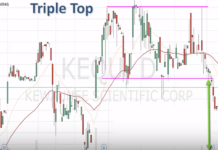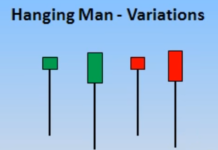Many of you probably met Wolfe Wave trading strategy in the network. Some info businessmen try to sell training on its basis, although this trading strategy doesn’t have anything difficult or secret. Today we’ll analyze what are these waves, the way to find them on the chart and the most important – the way to use this strategy for making a profit.
Before reading the article and writing your questions in the comments section, I recommend to watch this video. It’s not long but covers the biggest part of questions on the topic.
Table of Contents
What are the Wolfe Waves?
According to Elliott, the market has a Wave structure and is subject to certain pendulum movements. Many other researchers agree with him and some of them have developed their wave theories, Wolfe Waves is one of them.
Wolfe Waves are a reversal pattern which obeys very strict rules. This pattern is the most accurate and least subjective reversal figure.
This figure’s successful completion percentage is very high. Wolfe Waves learning is rather hard for newcomers, it’s better to start learning this trading strategy after a year of trading. This pattern is found on almost all timeframes and is processed on all tools.
According to Newtonian mechanics Every action has its opposition. Wolfe Wave trading strategy has been developed while taking this statement as a basis. The price, like a pendulum, swings from side to side: up and down. Its movements are not so chaotic as it might seem. Today we will learn to see the almost invisible that is missed by other traders.
Let’s pay attention to the picture below. This is “Bullish Wolfe Pattern”. All the waves in this pattern are numbered, they are all important and each wave has its specific function.
Bullish Wolfe Pattern
- Point 1 – the first of three model definition points;
- Wave 1-2 – the basic model foundation. The whole model is its continuation;
- Point 2 – the first vertex of the vibrational price movement. Must be above point 1;
- Point 3 is the second of three model definition points. Is the minimum achieved after wave 1-2? Should be located on the chart below point 1;
- Wave 3-4 – the second wave in our pattern;
- Point 4 – the maximum of the second wave of our pattern. Should be located below the second and above the third point;
- Point 5 – the third point in the model definition. Is the minimum achieved after wave 3-4? Located on the line drawn from point 1 to point 3. Should be located below the third point. This is our entry point. The pattern is considered acceptable for the trade started after reaching this point;
- Points 1-3-5 – are located on the same line;
- Point 6 is our goal. It is located on the line drawn from point 1 to point 4. All positions are closed and the pattern is considered to be spent after reaching point 6;
- Wave 5-6 is the strongest and only traded Wolfe wave;
- Points 1-4-6 are located on the same line.

Bearish Wolfe pattern
- Point 1 – the first of three model definition points;
- Wave 1-2 – the basic model foundation. The whole model is its continuation;
- Point 2 – the first vertex of the vibrational price movement. Should be located below point 1;
- Point 3 – the second of three points of model definition. It is the maximum achieved after wave 1-2. Should be located on the chart above point 1;
- Wave 3-4 – the second wave in our pattern;
- Point 4 is the minimum of the second wave of our pattern. Should be located below the second and the third point;
- Point 5 – the third point in the model definition. It is the maximum achieved after wave 3-4. Located on the line drawn from point 1 to point 3. Should be located above the third point. This is our entry point. This is our entry point. The pattern is considered acceptable for the trade started after reaching this point;
- Points 1-3-5 – are located on the same line;
- Point 6 is our goal. It is located on the line drawn from point 1 to point 4. All positions are closed and the pattern is considered to be spent after reaching point 6;
- Wave 5-6 – the strongest and only traded Wolfe wave;
- Points 1-4-6 are located on the same line.
These rules describe the ideal Wolfe patterns. Such situations arise quite rarely and in reality, as usual, there are some features. Let’s see them:
Features which arise when working with the fourth point
Often, at the fourth point’s formation time, the market can flutter or the price shows a triangle, it is rather difficult to find the true fourth point in the resulting vertices hash.
We meet a difficult situation and are not sure which of the lines drawn from point 1 to point 4 will be the true target line for the point 6 formation. Let’s take into account all of them. Yes, yes, you did not misinterpret. Now we have many points 6.
Wolfe pattern. Features which arise when working with the fourth point
Let’s pay attention to the bearish pattern in the picture above. According to this schematic image, the result is all points 6 located on the line 1-4 were spent, but this might not have happened.
We need to calculate our lot in such a way while closing it slightly at each point of touching lines 1-4 if we are not sure of the final goal. Or we can push the stop-loss after passing each line 1-4.
All positions are being closed when reaching point 6. Further movement may continue or rebound. These events probability is 50%. Never ignore the exit rule at the last 6th point.
Features which arise when working with the fourth point of the Wolfe pattern
Sweet zones in the Wolfe pattern
We need to gain liquidity to start moving from point 5 to point 6. In connection with this, sometimes point 5 is below the line 1-3 or often spits it.
The zone which is located below the 5th point on the line 1-3 is called the sweet zone. Entering the deals in this zone is considered to be the most profitable.
It’s is quite simple to outline this zone boundaries. It is necessary to draw an auxiliary line between vertices 2 and 4. Duplicate this line strictly parallelly and transfer it to the point 3. In case the line drawn from the 2nd to the 4th point is parallel to the line drawn through the points 1-3, there is no tasty zone.
Most likely you did something wrong and this is not a Wolfe Wave pattern at all if the angle is drawn from the point 3 of our intended point 5 in the tasty zone is too wide concerning the line 1-3.
Let’s search for 3 points (maximum or minimum) which are located on the same line on the chart. Check if there are vertices 2 and 4 near them. Let’s verify the vertices location according to the bearish or bullish pattern rules (see above).
Conclusion
Wolfe pattern is one of the most effective tools of wave technical analysis even considering the fact it is a rather complex figure for perception which requires long training for its detection.
The result of using this pattern will surpass all your expectations and assumptions about its use. Despite the apparent impossibility of forming such a complex figure on the chart, it is formed very often and is also one of the most profitable.






Are these patterns not the same as rising wadge and falling wedge???
wow….I have always been intrigued by this and I never succeeded using it. Now I see that it involves “symmetry”. Thanks for this article
Maybe the most ubiquitous pattern in the daily time frame and the most I have in my archive, unfortunately, I seldom trade in this time frame
Very similar to an elliott ending diagonal
Please lay more emphasis on setting stop losses with the strategy
Smart strategy
Keep up doing the same thing
Caution caution to the newbies here…. Take your time. This strategy will require time investment